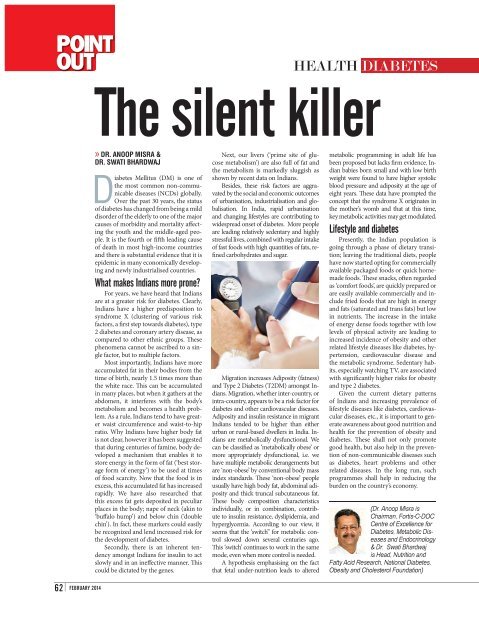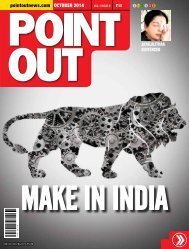FEBRUARY 2014
Create successful ePaper yourself
Turn your PDF publications into a flip-book with our unique Google optimized e-Paper software.
POINT<br />
OUT<br />
HEALTH DIABETES<br />
The silent killer<br />
» DR. ANOOP MISRA &<br />
DR. SWATI BHARDWAJ<br />
Diabetes Mellitus (DM) is one of<br />
the most common non-communicable<br />
diseases (NCDs) globally.<br />
Over the past 30 years, the status<br />
of diabetes has changed from being a mild<br />
disorder of the elderly to one of the major<br />
causes of morbidity and mortality affecting<br />
the youth and the middle-aged people.<br />
It is the fourth or fifth leading cause<br />
of death in most high-income countries<br />
and there is substantial evidence that it is<br />
epidemic in many economically developing<br />
and newly industrialised countries.<br />
What makes Indians more prone?<br />
For years, we have heard that Indians<br />
are at a greater risk for diabetes. Clearly,<br />
Indians have a higher predisposition to<br />
syndrome X (clustering of various risk<br />
factors, a first step towards diabetes), type<br />
2 diabetes and coronary artery disease, as<br />
compared to other ethnic groups. These<br />
phenomena cannot be ascribed to a single<br />
factor, but to multiple factors.<br />
Most importantly, Indians have more<br />
accumulated fat in their bodies from the<br />
time of birth, nearly 1.5 times more than<br />
the white race. This can be accumulated<br />
in many places, but when it gathers at the<br />
abdomen, it interferes with the body’s<br />
metabolism and becomes a health problem.<br />
As a rule, Indians tend to have greater<br />
waist circumference and waist-to-hip<br />
ratio. Why Indians have higher body fat<br />
is not clear, however it has been suggested<br />
that during centuries of famine, body developed<br />
a mechanism that enables it to<br />
store energy in the form of fat (‘best storage<br />
form of energy’) to be used at times<br />
of food scarcity. Now that the food is in<br />
excess, this accumulated fat has increased<br />
rapidly. We have also researched that<br />
this excess fat gets deposited in peculiar<br />
places in the body; nape of neck (akin to<br />
‘buffalo hump’) and below chin (‘double<br />
chin’). In fact, these markers could easily<br />
be recognized and lend increased risk for<br />
the development of diabetes.<br />
Secondly, there is an inherent tendency<br />
amongst Indians for insulin to act<br />
slowly and in an ineffective manner. This<br />
could be dictated by the genes.<br />
Next, our livers (‘prime site of glucose<br />
metabolism’) are also full of fat and<br />
the metabolism is markedly sluggish as<br />
shown by recent data on Indians.<br />
Besides, these risk factors are aggravated<br />
by the social and economic outcomes<br />
of urbanisation, industrialisation and globalisation.<br />
In India, rapid urbanisation<br />
and changing lifestyles are contributing to<br />
widespread onset of diabetes. More people<br />
are leading relatively sedentary and highly<br />
stressful lives, combined with regular intake<br />
of fast foods with high quantities of fats, refined<br />
carbohydrates and sugar.<br />
Migration increases Adiposity (fatness)<br />
and Type 2 Diabetes (T2DM) amongst Indians.<br />
Migration, whether inter-country, or<br />
intra-country, appears to be a risk factor for<br />
diabetes and other cardiovascular diseases.<br />
Adiposity and insulin resistance in migrant<br />
Indians tended to be higher than either<br />
urban or rural-based dwellers in India. Indians<br />
are metabolically dysfunctional. We<br />
can be classified as ‘metabolically obese’ or<br />
more appropriately dysfunctional, i.e. we<br />
have multiple metabolic derangements but<br />
are ‘non-obese’ by conventional body mass<br />
index standards. These ‘non-obese’ people<br />
usually have high body fat, abdominal adiposity<br />
and thick truncal subcutaneous fat.<br />
These body composition characteristics<br />
individually, or in combination, contribute<br />
to insulin resistance, dyslipidemia, and<br />
hyperglycemia. According to our view, it<br />
seems that the ‘switch” for metabolic control<br />
slowed down several centuries ago.<br />
This ‘switch’ continues to work in the same<br />
mode, even when more control is needed.<br />
A hypothesis emphasising on the fact<br />
that fetal under-nutrition leads to altered<br />
metabolic programming in adult life has<br />
been proposed but lacks firm evidence. Indian<br />
babies born small and with low birth<br />
weight were found to have higher systolic<br />
blood pressure and adiposity at the age of<br />
eight years. These data have prompted the<br />
concept that the syndrome X originates in<br />
the mother’s womb and that at this time,<br />
key metabolic activities may get modulated.<br />
Lifestyle and diabetes<br />
Presently, the Indian population is<br />
going through a phase of dietary transition;<br />
leaving the traditional diets, people<br />
have now started opting for commercially<br />
available packaged foods or quick homemade<br />
foods. These snacks, often regarded<br />
as ‘comfort foods’, are quickly prepared or<br />
are easily available commercially and include<br />
fried foods that are high in energy<br />
and fats (saturated and trans fats) but low<br />
in nutrients. The increase in the intake<br />
of energy dense foods together with low<br />
levels of physical activity are leading to<br />
increased incidence of obesity and other<br />
related lifestyle diseases like diabetes, hypertension,<br />
cardiovascular disease and<br />
the metabolic syndrome. Sedentary habits,<br />
especially watching TV, are associated<br />
with significantly higher risks for obesity<br />
and type 2 diabetes.<br />
Given the current dietary patterns<br />
of Indians and increasing prevalence of<br />
lifestyle diseases like diabetes, cardiovascular<br />
diseases, etc., it is important to generate<br />
awareness about good nutrition and<br />
health for the prevention of obesity and<br />
diabetes. These shall not only promote<br />
good health, but also help in the prevention<br />
of non-communicable diseases such<br />
as diabetes, heart problems and other<br />
related diseases. In the long run, such<br />
programmes shall help in reducing the<br />
burden on the country’s economy.<br />
(Dr. Anoop Misra is<br />
Chairman, Fortis-C-DOC<br />
Centre of Excellence for<br />
Diabetes, Metabolic Diseases<br />
and Endocrinology<br />
& Dr. Swati Bhardwaj<br />
is Head, Nutrition and<br />
Fatty Acid Research, National Diabetes,<br />
Obesity and Cholesterol Foundation)<br />
62<br />
<strong>FEBRUARY</strong> <strong>2014</strong>













